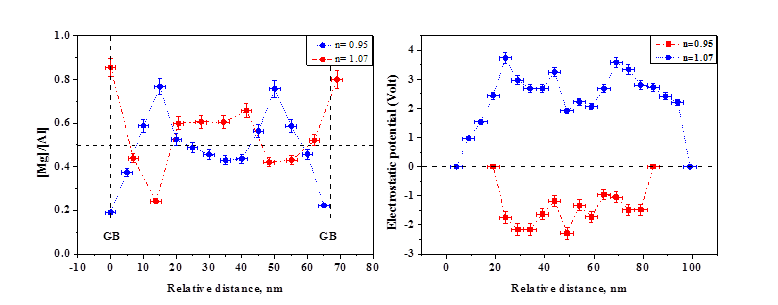
MEASURING THE SPACE CHARGE POTENTIAL IN GRANULAR MAGNESIUM ALUMINATE SPINEL USING OFF-AXIS ELECTRON HOLOGRAPHY
2Department of Materials Science and Engineering, Tel Aviv University, Tel Aviv
Solute and point defects segregation to grain boundaries are fundamental phenomena in polycrystalline ionic materials [1,2]. Therefore, it is important to investigate the influence of this segregation adjacent to grain boundaries on the defect chemistry and space charged zone (SCZ) [3]. The classical approach for estimating the space charge potential (SCP) in ionic materials is based on defect concentration and formation energy using Boltzmann distribution [2,3]. These estimates are inaccurate because values of the defects formation energy are usually unknown. Additionally, assumptions used [2, 3] for distribution of charge carriers (defects) in SCZ correspond to semiconductors and not to ionic materials. Thus, more realistic models should be developed, for which experimental measurements of the SCZ are required. Here, the SCP is estimated in model systems of MgO·0.95Al2O3 and MgO·1.07Al2O3 spinel using off-axis electron holography (OAEH) [4]. Consequently, the relations between GB segregation (Fig. 1a), electrostatic potential (Fig. 1b) and heat treatment on the SCP are discussed.
Reference List:
[1] M. Rubat du Merac et al., J Am Ceram Soc. 96 (2013) 3341-3365.
[2] N. Nuns, F. Béclin et al., J Am Ceram Soc. 92 (2009) 870-875.
[3] Y. Chiang et al., J Am Ceram Soc. 73 (1990) 1153-1158.
[4] A. Pantzer et al., Ultramicroscopy 138 (2014) 36-45.

Figure 1- a: Line profiles perpendicular to grain boundaries of cation concentration ratio (Mg to Al) as calculated from EELS measurements. b: Line profiles perpendicular to grain boundaries of the electrostatic potential of SCZ as calculated from OAEH measurements. Note: MgO∙nAl2O3 stoichiometric ratios, n=0.95 (red) and 1.07 (blue) heated at 1200°C by SPS
Powered by Eventact EMS